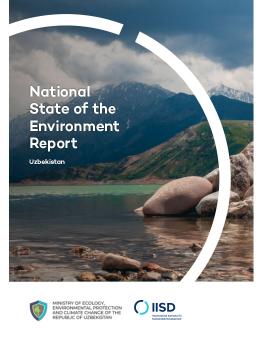
National State of the Environment Report: Uzbekistan
A healthy environment and its sustainable management are critical for citizens' well-being and supporting Uzbekistan's growing economy. The National State of the Environment Report (NSoER) is a comprehensive document that provides a snapshot of current environmental trends in Uzbekistan's socio-economic development for citizens, experts, and policy-makers. This report was prepared with the support of the United Nations Economic Commission for Europe, the United Nations Environment Programme (UNEP), and the Food and Agriculture Organization of the United Nations, along with financial support from the Global Public Goods and Challenges Programme Cooperation Agreement between the European Commission and UNEP.
-
A decade of environmental change is captured in the recent National State of the Environment Report of Uzbekistan.
-
The National State of the Environment Report is a comprehensive document that provides a snapshot of current environmental trends in Uzbekistan's socio-economic development for citizens, experts, and policy-makers.
-
Decade of trends for critical environmental issues, including air, water, and biodiversity, are reviewed in the recent National State of the Environment Report.
The analyzed environmental trends need to inform decision making and improve citizen engagement in natural resource management and environmental protection. This report thus aims to connect actions creating drivers and pressures influencing the state of the environment and relevant responses to address environmental challenges.
Our approach uses the Drivers– Pressures–State–Impacts–Responses (DPSIR) framework to draw connections between the state of the environment and the drivers and pressures on the environment. The framework brings together five critical elements of development in a connected framework to integrate the causes of environmental degradation (as well as environmental improvements) into a chain of causes and consequences. The DPSIR framework provides a suitable model for describing the interaction between human activities and the environment.
Based on the application of the DPSIR framework, the NSoER team, with the participation of stakeholders, identified the specific drivers, pressures, and components of the environment, such as atmospheric air, water resources, land, and specific ecosystems.
Participating experts
You might also be interested in
Border Carbon Adjustments: Trinidad and Tobago country report
This report consolidates, analyzes, and presents views and perspectives of stakeholders from Trinidad and Tobago on border carbon adjustment (BCA) schemes to contribute to the global debate on BCA good practices.
How Can We Work With Nature to Tackle Drought and Desertification?
Drought is one of the most devastating and pervasive challenges exacerbated by climate change. However, we can work to reduce its effects through nature-based solutions for land restoration and climate-smart agriculture.
Carbon Minefields: Oil and gas exploration surging to pre-Covid levels
Oil and gas exploration is booming despite an agreement at last year’s COP 28 climate summit to transition away from fossil fuels.
July Edition | Carbon Minefields Oil and Gas Exploration Monitor
In June 2024, six governments issued 18 oil and gas exploration licences with embodied emissions of 14.7 MtCO2, led by Russia and China.